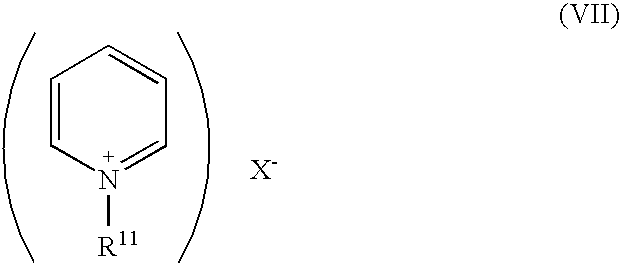External additive for electrostatically charged image developing toner
an electrostatically charged, toner technology, applied in the field of external additives, can solve the problems of affecting charging, poor reproducibility of image density, and large difference in chargeability, and achieve the effect of not causing adhesion of toner and good flowability
- Summary
- Abstract
- Description
- Claims
- Application Information
AI Technical Summary
Benefits of technology
Problems solved by technology
Method used
Image
Examples
example 1
Synthesis of Spherical Hydrophobic Fine Silica Particles
[0055](Step 1) In a 3-liter glass reaction vessel having a stirrer, a dropping funnel and a thermometer, 623.7 g of methanol, 41.4 g of water and 49.8 g of 28% ammonia water were added and then mixed. The resultant solution was set at 35° C., and 1,163.7 g of tetramethoxysilane and 418.1 g of 5.4% ammonia water began to be simultaneously added thereto with stirring the solution, where the former was dropped over 6 hours and the latter was dropped over a period of 4 hours. After the dropwise addition of the tetramethoxysilane, the solution was still continued to be stirred for 0.5 hour to carry out hydrolysis, and thus a suspension of fine silica particles was obtained. After the glass reaction vessel was fitted with an ester adapter and a condenser, the dispersion was heated to 60 to 70° C. to distil off 1,132 g of methanol, whereupon 1,200 g of water was added, followed by further heating to 70 to 90° C. to distil off 273 g of...
example 2
[0078]467 g of spherical hydrophobic fine silica particles having an average particle diameter of 0.30 μm were obtained in the same manner as in Example 1, except that the temperature 35° C. for hydrolysis of tetramethoxysilane in synthesis of the spherical hydrophobic fine silica particles was changed to 20° C.
[0079]Using the hydrophobic fine silica particles thus obtained, evaluation was made in the same manner as in Example 1. The results are shown in Table 1.
example 3
[0080]469 g of spherical hydrophobic fine silica particles having an average particle diameter of 0.09 μm was obtained in the same manner as in Example 1, except that the temperature 35° C. for hydrolysis of tetramethoxysilane in synthesis of the spherical hydrophobic fine silica particles was changed to 40° C.
[0081]Using the hydrophobic fine silica particles thus obtained, evaluation was made in the same manner as in Example 1. The results are shown in Table 1.
PUM
| Property | Measurement | Unit |
|---|---|---|
| particle diameter | aaaaa | aaaaa |
| temperature | aaaaa | aaaaa |
| particle diameter | aaaaa | aaaaa |
Abstract
Description
Claims
Application Information
 Login to View More
Login to View More - R&D
- Intellectual Property
- Life Sciences
- Materials
- Tech Scout
- Unparalleled Data Quality
- Higher Quality Content
- 60% Fewer Hallucinations
Browse by: Latest US Patents, China's latest patents, Technical Efficacy Thesaurus, Application Domain, Technology Topic, Popular Technical Reports.
© 2025 PatSnap. All rights reserved.Legal|Privacy policy|Modern Slavery Act Transparency Statement|Sitemap|About US| Contact US: help@patsnap.com



